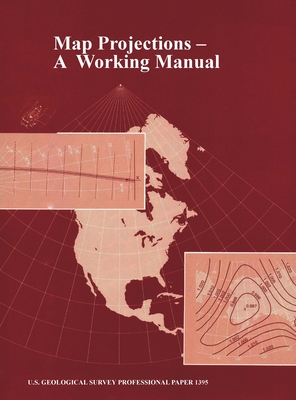
Map Projections: A Working Manual (U.S. Geological Survey Professional Paper 1395)
Hardcover
ISBN13: 9781839310218
Publisher: Www Militarybookshop Co Uk
Published: Oct 31 2012
Pages: 406
Weight: 2.70
Height: 0.94 Width: 8.50 Depth: 11.00
Language: English
1 different editions
Also available
Map Projections: A Working Manual (U.S. Geological Survey Professional Paper 1395)
Snyder, John P.
Paperback
Also in
Geography
National Geographic Concise Atlas of the World, 5th Edition: Authoritative and Complete, with More Than 200 Maps and Illustrations
National Geographic
Paperback
Atlas of the Invisible: Maps and Graphics That Will Change How You See the World
Uberti, Oliver
Cheshire, James
Hardcover
Treasury of Folklore: Woodlands and Forests: Wild Gods, World Trees and Werewolves
Winsham, Willow
Chainey, Dee Dee
Hardcover
Report of the Chief Engineer of the State of Tennesse: On the Surveys and Examinations for the Central Railroad, and for the Central Turnpike
Engineer, Tennessee Chief
Hardcover
Picturesque Palestine, Arabia and Syria; the Country, the People and the Landscape
Grober, Karl
Hardcover
Thematic Cartography and Geovisualization: International Student Edition
Kessler, Fritz C.
Slocum, Terry A.
McMaster, Robert B.
Paperback
Discover QGIS 3.x - Second Edition: A Workbook for Classroom or Independent Study
Menke, Kurt
Paperback
For the Sake of Forests and Gods: Governing Life and Livelihood in the Philippine Uplands
Dressler, Wolfram H.
Paperback
Upper Left Cities: A Cultural Atlas of San Francisco, Portland, and Seattle
Shobe, Hunter
Banis, David
Hardcover
The ESRI Guide to GIS Analysis, Volume 3: Modeling Suitability, Movement, and Interaction
Mitchell, Andy
Paperback
Christopher Gist of Maryland and Some of His Descendants, 1679-1957 / by Jean Muir Dorsey and Maxwell Jay Dorsey.
Dorsey, Jean Muir 1890-
Paperback
ArcGIS Pro 3.x Cookbook - Second Edition: Create, manage, analyze, maintain, and visualize geospatial data using ArcGIS Pro
Gisp, Tripp Corbin
Paperback
Life Lessons from Explorers: Learn How to Weather Life's Storms from History's Greatest Explorers
Publishing, Welbeck
Aston, Felicity
Hardcover
Countries of the World in Minutes: Histories, Key Data, and Maps for All 195 Countries
Field, Jacob F.
Paperback
Minus 148 Degrees, Anniversary Edition: First Winter Ascent of Mount McKinley, Anniversary Edition
Davidson, Art
Paperback
Ancient Landscapes of Western North America: A Geologic History with Paleogeographic Maps
Blakey, Ronald C.
Ranney, Wayne D.
Hardcover
Picturesque Palestine, Arabia and Syria; the Country, the People and the Landscape
Grober, Karl
Paperback
Inventio Fortunata: Arctic Exploration, With An Account Of Nicholas Of Lynn
Decosta, Benjamin Franklin
Paperback
The Taste of Water: Sensory Perception and the Making of an Industrialized Beverage Volume 15
Spackman, Christy
Paperback
The Guyot Geographical Reader and Primer: A Series of Journeys Round the World
Guyot, Arnold
Pratt, Mary Howe Smith
Paperback
Mountains Before Mountaineering: The Call of the Peaks Before the Modern Age
Hollis, Dawn L.
Hardcover
Christopher Gist of Maryland and Some of His Descendants, 1679-1957 / by Jean Muir Dorsey and Maxwell Jay Dorsey.
Dorsey, Jean Muir 1890-
Hardcover
The Journal of Christopher Columbus During his First Voyage, 1492-93 and Documents
Christopher, Columbus
Paperback
IB Geography Internal Assessment: The Definitive Geography [HL/SL] IA Guide For the International Baccalaureate [IB] Diploma
Zouev, Alexander
Piotrowska, Joanna
Paperback
L'Amérique Méridionale: The Map That Shaped Brazil in the 18th Century
Ferreira Furtado, Junia
Hardcover
A Narrative or Journal of a Voyage of Discovery to the North Pacific Ocean and Round the World [microform]: Performed in the Years 1791, 1792, 1793, 1
Broughton, William Robert 1762-1821
Vancouver, George 1757-1798
Paperback
The Third and Last Voyage of Captain Cook [microform]: With an Introduction by Hugh Reginald Haweis
Cook, James 1728-1779
Paperback
Rivers of Power: How a Natural Force Raised Kingdoms, Destroyed Civilizations, and Shapes Our World
Smith, Laurence C.
Hardcover
Around Switzerland in 80 Maps: A Truly Magical and Engrossing Journey Across Switzerland's History
Bewes, Diccon
Paperback
Pirates and Buried Treasure on Florida Islands, Including the Gasparilla Story
Beater, Jack
Hardcover
Professional Surveyors and Real Property Descriptions: Composition, Construction, and Comprehension
Estopinal, Stephen V.
Lathrop, Wendy
Hardcover
GIS For Surveyors: A Land Surveyor's Introduction to Geographic Information Systems
Zimmer, Rj
Paperback
Culture and Archaeology of the Ancestral Unangax̂/Aleut of the Aleutian Islands, Alaska: Unangam Tanangin Ilan Unangax̂/Aliguutax̂ Maqa
Corbett, Debra
Hanson, Diane
Hardcover
Journal of a Voyage Between China and the North-Western Coast of America [microform]: Made in 1804
Shaler, William 1778-1833
Paperback
Garner-Keene Families of Northern Neck, Virginia, by Ruth Ritchie and Sudie Rucker Wood.
Ritchie, Ruth 1903-
Paperback
Personal Narrative of Travels to the Equinoctial Regions of America, During the Year 1799-1804: (Volume II)
Humboldt, Alexander Von
Paperback
Globale Erderwärmung Und Migration: Der Klimawandel Und Seine Auswirkungen Auf Die Migration in Den Norden
Soukharev, Boris
Paperback
Small-Format Aerial Photography and Uas Imagery: Principles, Techniques and Geoscience Applications
Ries, Johannes
Aber, James S.
Marzolff, Irene
Paperback
Stranded at the Top of the World: A Story of Exploration and Heroic Rescue in the Arctic
Tahan, Mary R.
Lüdecke, Cornelia
Hardcover
Tecnologías de la Información Geográfica (TIG). Vol. 2: Cartografía, Fotointerpretación, Teledetección y SIG
Quirós Hernández, Manuel
Paperback
Early Expeditions to the Region of Bering Sea and Strait: From the Reports and Journals of Vitus Ivanovich Bering
Dall, William Healey
Stromeyer, Georg Friedrich Louis
Bering, Vitus Jonassen
Paperback
World Flags: Color By Number For Adults: Bring The Country Flags To Life With This Fun And Relaxing Coloring Book
Books, B. C. Lester
Paperback


 Sign-In
Sign-In Cart
Cart